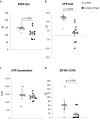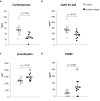Molecular pattern of a decrease in the rewarding effect of cocaine after an escalating-dose drug regimen
- PMID: 36586075
- PMCID: PMC9889529
- DOI: 10.1007/s43440-022-00443-3
Molecular pattern of a decrease in the rewarding effect of cocaine after an escalating-dose drug regimen
Abstract
Background: Long-term cocaine exposure leads to dysregulation of the reward system and initiates processes that ultimately weaken its rewarding effects. Here, we studied the influence of an escalating-dose cocaine regimen on drug-associated appetitive behavior after a withdrawal period, along with corresponding molecular changes in plasma and the prefrontal cortex (PFC).
Methods: We applied a 5 day escalating-dose cocaine regimen in rats. We assessed anxiety-like behavior at the beginning of the withdrawal period in the elevated plus maze (EPM) test. The reinforcement properties of cocaine were evaluated in the Conditioned Place Preference (CPP) test along with ultrasonic vocalization (USV) in the appetitive range in a drug-associated context. We assessed corticosterone, proopiomelanocortin (POMC), β-endorphin, CART 55-102 levels in plasma (by ELISA), along with mRNA levels for D2 dopaminergic receptor (D2R), κ-receptor (KOR), orexin 1 receptor (OX1R), CART 55-102, and potential markers of cocaine abuse: miRNA-124 and miRNA-137 levels in the PFC (by PCR).
Results: Rats subjected to the escalating-dose cocaine binge regimen spent less time in the cocaine-paired compartment, and presented a lower number of appetitive USV episodes. These changes were accompanied by a decrease in corticosterone and CART levels, an increase in POMC and β-endorphin levels in plasma, and an increase in the mRNA for D2R and miRNA-124 levels, but a decrease in the mRNA levels for KOR, OX1R, and CART 55-102 in the PFC.
Conclusions: The presented data reflect a part of a bigger picture of a multilevel interplay between neurotransmitter systems and neuromodulators underlying processes associated with cocaine abuse.
Keywords: Cocaine binge; HPA axis; KOR; Neuromodulators; OX1R; microRNA.
© 2022. The Author(s).
Conflict of interest statement
The authors declare no conflict of interest.
Figures





Similar articles
-
Persistent increases in rat hypothalamic POMC gene expression following chronic withdrawal from chronic "binge" pattern escalating-dose, but not steady-dose, cocaine.Neuroscience. 2015 Mar 19;289:63-70. doi: 10.1016/j.neuroscience.2014.12.078. Epub 2015 Jan 13. Neuroscience. 2015. PMID: 25595971 Free PMC article.
-
Effects of selective D1- or D2-like dopamine receptor antagonists with acute "binge" pattern cocaine on corticotropin-releasing hormone and proopiomelanocortin mRNA levels in the hypothalamus.Brain Res Mol Brain Res. 2004 Nov 4;130(1-2):61-7. doi: 10.1016/j.molbrainres.2004.07.008. Brain Res Mol Brain Res. 2004. PMID: 15519677
-
Alterations in hypothalamic-pituitary-adrenal axis activity and in levels of proopiomelanocortin and corticotropin-releasing hormone-receptor 1 mRNAs in the pituitary and hypothalamus of the rat during chronic 'binge' cocaine and withdrawal.Brain Res. 2003 Feb 28;964(2):187-99. doi: 10.1016/s0006-8993(02)03929-x. Brain Res. 2003. PMID: 12576179
-
CART mRNA expression in rat monkey and human brain: relevance to cocaine abuse.Physiol Behav. 2007 Sep 10;92(1-2):218-25. doi: 10.1016/j.physbeh.2007.05.027. Epub 2007 May 21. Physiol Behav. 2007. PMID: 17631364 Review.
-
A neuroendocrine role in cocaine reinforcement.Psychoneuroendocrinology. 1997 May;22(4):237-59. doi: 10.1016/s0306-4530(97)00027-9. Psychoneuroendocrinology. 1997. PMID: 9226728 Review.
Cited by
-
Adult rat ultrasonic vocalizations and reward: Effects of propranolol and repeated cocaine administration.J Psychopharmacol. 2024 Nov;38(11):1025-1041. doi: 10.1177/02698811241268894. Epub 2024 Aug 12. J Psychopharmacol. 2024. PMID: 39129423 Free PMC article.
References
-
- Antelman SM, Eichler AJ, Black CA, Kocan D. Interchangeability of stress and amphetamine in sensitization. Science. 1980;207:329–331. - PubMed
-
- Haile CN, GrandPre T, Kosten TA. Chronic unpredictable stress, but not chronic predictable stress, enhances the sensitivity to the behavioral effects of cocaine in rats. Psychopharmacology. 2001;154:213–220. - PubMed
-
- Haile CN, Hiroi N, Nestler EJ, Kosten TA. Differential behavioral responses to cocaine are associated with dynamics of mesolimbic dopamine proteins in Lewis and Fischer 344 rats. Synapse. 2001;41:179–190. - PubMed
-
- Keralapurath MM, Briggs SB, Wagner JJ. Cocaine self-administration induces changes in synaptic transmission and plasticity in ventral hippocampus. Addict Biol. 2017;22:446–456. - PubMed
MeSH terms
Substances
Grants and funding
LinkOut - more resources
Full Text Sources
Medical
Miscellaneous
